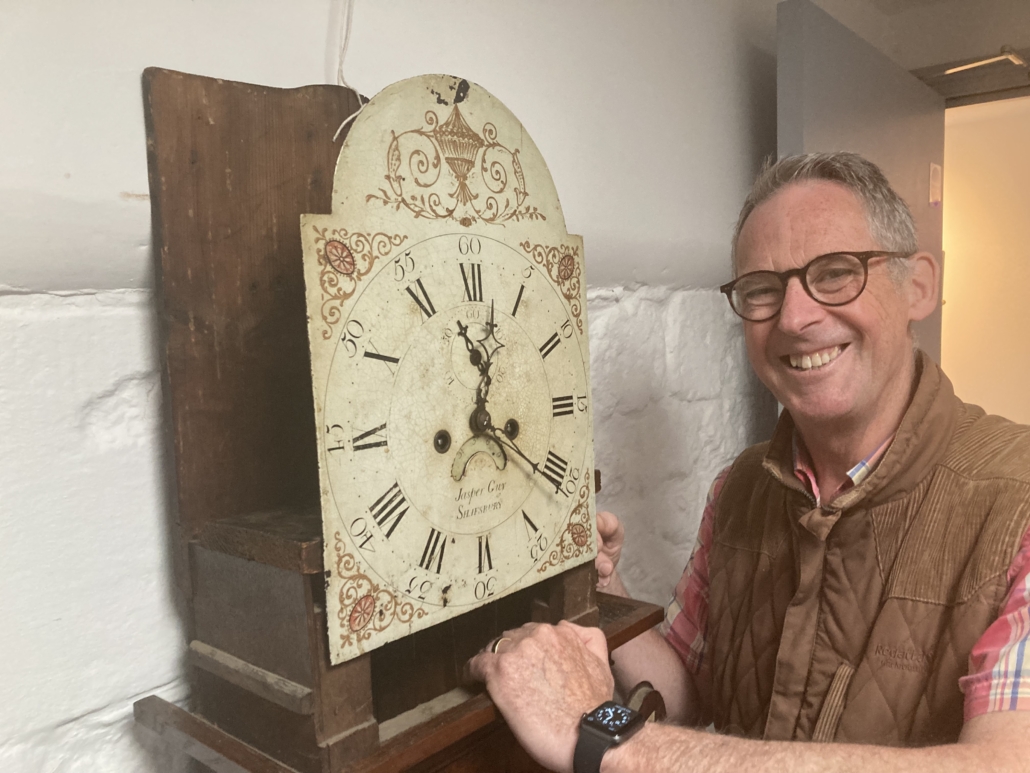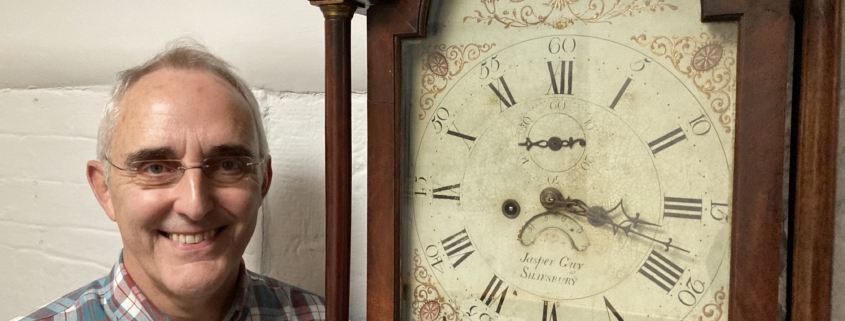A Dynasty of Shaftesbury Clockmakers, All Named Jasper Guy
In April Gold Hill Museum was delighted to receive the generous donation of an antique Shaftesbury-made longcase clock from Historical Society member Phil Proctor. Painted on the clock face above Shafsbury was, it was reasonable to assume, the name of the maker, Jasper Guy, though he might only have been the supplier. The installation of the clock on the first-floor landing, where it continues to keep good time, display the date, and strike the hours, prompted a surge of interest in the Guy family and clockmakers in Shaftesbury. The Pigot and Co. trade directory for 1830 lists five watchmakers: Frederick Belzoni of Bell Street; John Cole of Salisbury Street; Jasper Guy and Robert James, both of High Street; and Thomas Mansfield of Salisbury Street. If five seems a high number for a small rural town, Tribe and Whatmoor comment in Dorset Clocks and Clockmakers (1981) that clockmaking was strong and continuous in Shaftesbury … Surprisingly from the evidence so far of the known seventeenth-century lantern clocks, Shaftesbury and Sherborne were the homes of the earliest established makers.
In 1842 according to Pigot there were four watch and clockmakers: Frederick Belloni (sic) of High Street; Jasper Guy of Salisbury Street; William Guy of High Street; and Joseph Mansfield of Salisbury Street. This was not the same Jasper Guy as 1830, however, but probably his son. On 14 November 1831 the Salisbury and Winchester Journal reported: Died Wednesday last, after a short illness, deeply and deservedly lamented by all who knew him, Mr Jasper Guy, auctioneer etc of Shaftesbury aged 61 years. The sale of the deceased’s property in January 1832 included wheel and straight barometers, and eight-day and thirty-hour clocks and alarums.
Neither of these Jasper Guys can have been the maker of our clock. As Tribe and Whatmoor state: It was thought that the dials and movements of the painted-face or white-dial clocks were purchased ready-made from manufacturers, particularly in Birmingham. It is now known that the dials alone, already painted to order, would more often have been supplied from the specialist firms and the clockmaker (using some expertise) would have assembled a movement to go with the dial … an 8-day movement, with certain mechanical complications [such as displaying the date] needed an additional plate (called a false-plate) between the dial and the movement. Very often the name of the factory which made the dial is cast into this iron false-plate.

Thanks to our President, we were fortunate enough to be able to call on the expertise of Jonathan Betts, who also advises the National Trust about their clocks. Jonathan inspected the false-plate and assigned a date of 1780 to our clock. This means that the maker, Jasper Guy, belongs to a previous generation, and was almost certainly father and grandfather to the Jasper Guys already mentioned. Our in-house genealogist, Linda Wilton, was able to clear up a lot of the confusion. (Linda hosts a Family History session at Gold Hill Museum on alternate Thursday mornings.) The first Jasper Guy was born in 1740 in Compton Valence, Dorset, and married Ann Elliot in Shaftesbury in 1768. He made our clock, using a bought-in painted face, and was buried in Shaftesbury in July 1801. Their son Jasper was born in 1771 and married Dorothy Hannen in 1804, dying in 1831. He still dealt in clocks but was widely respected as an auctioneer. The third Jasper Guy was born c.1808, married Jane Brockway in Cann in 1833, and seems to have moved to Beaminster by the time of the 1851 Census. An 1851 trade directory lists a Jasper Guy as a watch and clockmaker in Little Street, Beaminster. A fourth Jasper Guy was born in 1839 in Shaftesbury, but nobody of that name appears on a Dorset Census after 1851. The Central Somerset Gazette of August 1881 reported the theft at Somerton of one wood box, 7 pairs of spectacles, and 13 watch chains belonging to Jasper Guy an itinerant watch and clockmaker. A later report from March 1882 refers to an assault on Jasper Guy, a pedlar of Shaftesbury. It is tempting to assume that the fourth Jasper Guy took inherited family skills on the road and away from Dorset.
Hear donor Phil Proctor and Family History researcher Linda Wilton talk about the clock and Jasper Guy to Keri Jones on the Alfred Daily by clicking here



